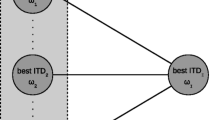Abstract
As was shown before (Roufs and Blommaert 1981), temporal impluse responsses and step responses can be obtained psychophysically using a driftcorrecting perturbation technique. In this paper, experimentally determined impulse responses are given for eight subjects using different experimental conditions, i.e. a 1 deg stimulus field at background luminances of 1200Td and 100Td, and a point source superimposed on an extended background of the same luminances, which is a possibility to separate transient and sustained processing. For a large class of stimuli, predictions of threshold curves and latency of different time functions are calculated on the basis of these measured impulse responses. Predictions are tested against experimental data. It will be shown that a simple model, only consisting of a linear filter followed by a noisy peak detector, suffices for a fair quantitative description of the available data.
Similar content being viewed by others
References
Blommaert FJJ (1979) Local visual responses in space and time. IPO Ann Prog Rpt 14:88–94
Breitmeyer BG, Ganz L (1976) Implications of sustained and transient channels for theories of visual pattern masking, saccadic suppression and information processing. Psychol Rev 83:1–36
Broekhuysen M, Rashbass C, Veringa F (1976) The thresholds of visual transients. Vision Res 16:1285–1289
De Voe RD (1967a) Nonlinear transient responses from lightadapted wolf-spider eyes to changes in background illumination. J Gen Physiol 50:1961–1991
De Voe RD (1967b) A nonlinear model for transient responses from light-adapted wolfspider eyes. J Gen Physiol 50:1993–2030
Foster DH (1971) A model for the human visual system and its response to certain classes of moving stimuli. Kybernetik 8:69–84
Gorea A, Tyler CW (1986) New look at Bloch's law for contrast. J Opt Soc Am A 3:52–61
Green M (1984) Masking by light and the sustained-transient dichotomy. Perc Psychoph 35:519–535
Kelly DH, Burbeek CA (1984) Critical problems in spatial vision. Crit Rev Biomed Eng 10(2):125–177
Krauskopf J (1981) Discrimination and detection of changes in luminance. Vision Res 20:671–677
Kulikowski JJ, Tolhurst DJ (1973) Psychophysical evidence for sustained and transient detectors in human vision. J Physiol 232:149–162
Nachmias J (1981) On the psychometric function for contrast detection. Vision Res 21:215–223
Quick RF (1974) A vector magnitude model of contrast detection. Kybernetik 16:65–67
Rashbass C (1970) The visibility of transient changes of luminance. J Physiol London 210:165–186
Rashbass C (1975) Unification of two contrasting models of the visual incremental threshold. Vision Res 16:1281–1283
Roufs JAJ (1963) Perception lag as a function of stimulus luminance. Vision Res 3:81–91
Roufs JAJ (1972a) Dynamic properties of vision-I. Experimental relationships between flicker and flash thresholds. Vision Res 12:261–278
Roufs JAJ (1972b) Dynamic properties of vision-II. Theoretical relationships between flicker and flash thresholds. Vision Res 12:279–292
Roufs JAJ (1973) Dynamic properties of vision-III. Twin flashes, single flashes and flicker fusion. Vision Res 13:309–323
Roufs JAJ (1974a) Dynamic properties of vision-IV. Thresholds of decremental flashes, incremental flashes and doublets in relation to flicker fusion. Vision Res 14:831–851
Roufs JAJ (1974b) Dynamic properties of vision-V. Perception lag and reaction time in relation to flicker and flash thresholds. Vision Res 14:853–869
Roufs JAJ (1974c) Dynamic properties of vision-VI. Stochastic threshold fluctuations and their effect on flash-to-flicker sensitivity ratio. Vision Res 14:871–888
Roufs JAJ, Blommaert FJJ (1981) Temporal impulse and step responses of the human eye obtained psychophysically by means of a drift-correcting perturbation technique. Vision Res 21:1203–1221
Roufs JAJ, Pellegrino Van Stuyvenberg JA (1976) Gain curve of the eye to subliminal sinusoidal modulation of light. IPO Ann Progr Rpt 11:56–63
Roufs JAJ, Piceni HAL, Pellegrino van Stuyvenberg JA (1987) The effect of noise on the analysis of the transient human visual system. Biol Cybern (submitted)
Watson AB (1979) Probability summation over time. Vision Res 19:515–522
Watson AB (1982) Derivation of the impulse response: comments on the method of Roufs and Blommaert. Vision Res 22:1335–1337
Watson AB, Nachmias J (1977) Patterns of temporal interaction in the detection of gratings. Vision Res 17:893–902
Author information
Authors and Affiliations
Rights and permissions
About this article
Cite this article
Blommaert, F.J.J., Roufs, J.A.J. Prediction of thresholds and latency on the basis of experimentally determined impulse responses. Biol. Cybernetics 56, 329–344 (1987). https://doi.org/10.1007/BF00319513
Received:
Issue Date:
DOI: https://doi.org/10.1007/BF00319513




